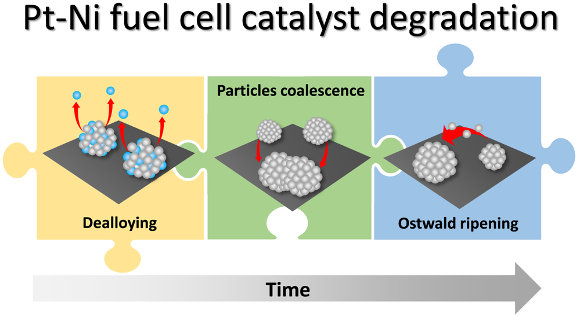Scientists gather insights on degradation processes of platinum-nickel alloy catalysts
|Proton-exchange membrane fuel cells (PEMFC) are among the most promising candidates for leading the transition from fossil fuels to green energy. However, the large-scale deployment of PEMFCs is hindered by issues like the high cost of the platinum catalyst and its stability. One of the most promising strategies to increase catalyst cost-efficiency is to employ platinum alloys with cheaper transitions metals, such as nickel. The problem, however, remains with durability because of the higher susceptibility of the alloy to corrosion and deactivation. A clear picture of the phenomena occurring during catalyst degradation would help develop corresponding mitigation strategies leading to a more robust catalyst.
Dr. Marco Bogar (CERIC-ERIC), Prof. Heinz Amenitsch (TU Graz), Dr. Ivan Khalakhan (Charles University), and colleagues realised a comprehensive study on time-resolved degradation of platinum-nickel catalysts during potentiodynamic cycling as a function of the alloy composition (nickel content from 0 to 75%) and PEMFC operation (upper potential 1.0 and 1.3 VRHE). Among the techniques employed in this study, in situ Grazing Incidence Small-Angle X-ray Scattering (GISAXS) provided in-depth mean morphological variations, and ex situ Scanning Electron Microscopy (SEM) helped to observe the formation of the cracks in the structure of the catalyst. The two techniques are available at the Austrian CERIC Partner Facility at Elettra Sincrotrone Trieste and the Czech CERIC Partner Facility at the Charles University, respectively.

This study was performed in the framework of the internal CERIC research project CEROP. By recording statistically meaningful parameters at the nm scale, scientists developed a methodology to distinguish between different phenomena causing catalyst degradation (dealloying, particle coalescence, and Ostwald ripening) and thus were able to realise time-dependent degradation maps to highlight the timeframe in which the specific phenomenon is prevailing. The results of this research and acquired experimental capabilities represent an important asset for future work that will address catalyst deterioration in diverse applied systems.



